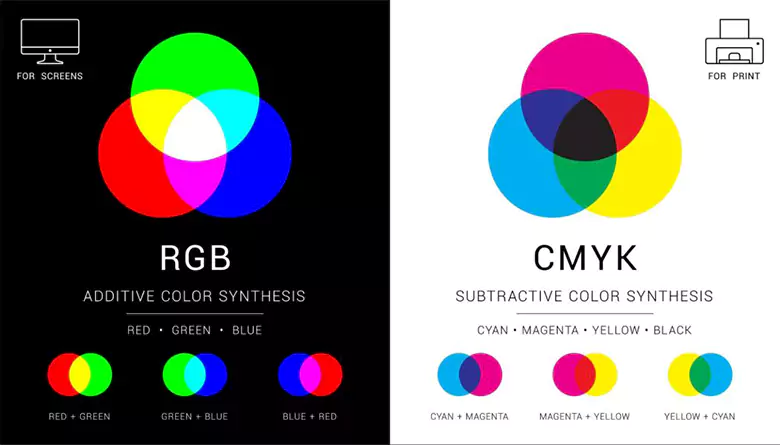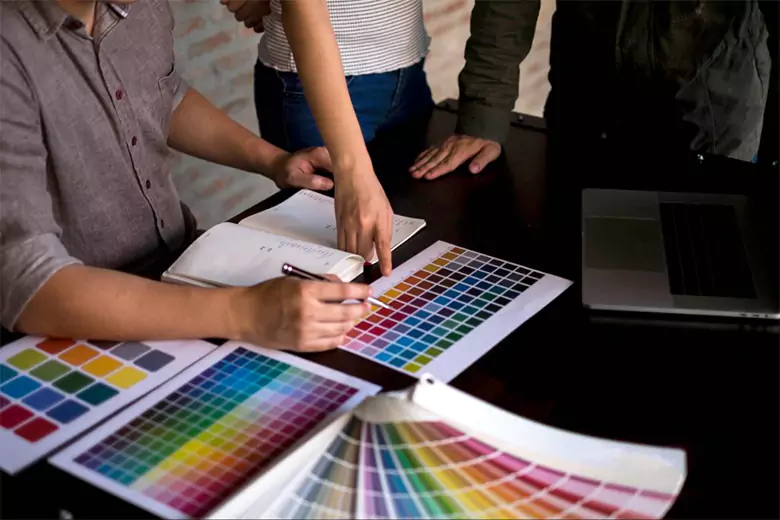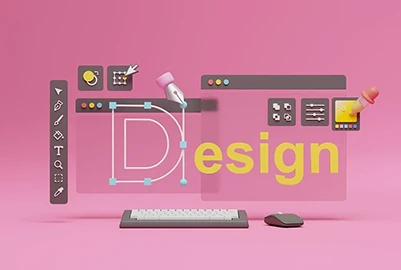Learn what the CMYK color model is, how it works, and how it compares to the RGB model — plus actionable tips and best practices.
In graphic design, a color model is a specific type of system or process used to create and reproduce colors.
The color model you use depends on the medium you’re designing for. If you’re creating digital designs to be displayed on a screen, the RGB color model is preferred. If you’re designing for print, CMYK is the go-to color model.
In this guide, we’ll focus on CMYK: a subtractive color model that’s crucial for ensuring accuracy, consistency, and quality for all kinds of printed designs.
Here’s what we’ll cover:
- What is the CMYK color model and how does it work?
- CMYK vs. RGB — what’s the difference?
- What is the CMYK color model used for in graphic design?
- Strengths and limitations of the CMYK color model
- Designing with CMYK: tips and best practices for graphic designers
- Key takeaways
By the end of this guide, you’ll have a clear understanding of what the CMYK model is, how it works, and why it’s so important in print design — essential knowledge if you’re working in graphic design or aspiring to do so in the future.

What is the CMYK color model and how does it work?
CMYK is the standard color model used in the printing industry. It stands for Cyan, Magenta, Yellow, and Key (which represents black), and it’s what’s known as a subtractive color model (we’ll explain what that means shortly).
The CMYK color model ensures that, when printing designs onto paper or other physical materials, the colors appear exactly as the designer intended.
So how does it work? Let’s take a look.
How does the CMYK color model work?
Let’s say you’ve designed a poster you want to print onto plain white paper. The white paper is your starting point, and it appears white to the human eye because it reflects all colors of light.
To print your poster, you use a standard printer that contains four ink cartridges: cyan (a bright, greenish-blue color), magenta (a purplish-red color), yellow, and black.
During the printing process, the printer transfers these different colored inks onto the paper in varying amounts and compositions (as dictated by your design). Once on the paper, the ink absorbs certain light wavelengths — effectively blocking or reducing the light that would otherwise be reflected. This has the effect of creating different colors.
Cyan ink, for example, absorbs red light and reflects green and blue light. Magenta ink absorbs green light and reflects red and blue light, while yellow ink absorbs blue light and reflects red and green light.
The ink essentially ‘subtracts’ or blocks certain light wavelengths to alter the colors that are created and perceived — and that’s why CMYK is described as a subtractive color model.

By layering these inks in different amounts, you can create a wide range of colors. If you layer cyan and yellow, you’ll get green. If you layer magenta and yellow, you’ll get red. Cyan and magenta combine to produce blue — and if you mix all three in equal amounts, you’ll get a dark brown color, or a color close to black.
For a deeper, more intense black color, printers use a separate black ink cartridge. This is more cost-effective than combining cyan, magenta, and yellow to produce black, and it creates crisper, sharper details (which is essential for fine lines and text).
In simple terms: The CMYK color model is like mixing paints. You start with a white canvas (paper), add colors (ink) that subtract light, and layer them to get the final picture.
Want to learn more about color? Check out the ultimate guide to color theory.
CMYK vs. RGB — what’s the difference?
The CMYK color model is used when printing designs onto paper (or other physical materials). If you’re creating digital designs for screens, you use a different system: the RGB color model.
RGB stands for Red, Green, and Blue, which are the three primary colors of light. While the CMYK model works by subtracting or blocking light, RGB is an additive color model that works by adding light.
When using the RGB model, you start with a completely dark screen — there’s no light. You then add red, green, and blue light in different intensities to create any color. If you add all three colors at full intensity, you get white light.
Similar to the CMYK model, the RGB model mixes its three core colors in varying amounts to create a spectrum of colors. You can mix red and green to create yellow, for example, or red and blue to create magenta.

The key differences between CMYK and RGB
The main differences between the CMYK and RGB color models can be summarized as follows:
- The RGB model works with three core colors: red, green, and blue. The CMYK model works with four core colors: cyan, magenta, yellow, and black.
- The RGB color model is used when designing for devices that emit light — such as a TV screen, a computer monitor, or a smartphone. The CMYK color model is used for devices that reflect light (like printers), making it the standard model for print design.
- The RGB color model is an additive model where colors are created by adding light. CMYK is a subtractive model where colors are created by subtracting or blocking light.
- The RGB model can create a wider range of brighter, more vibrant colors. CMYK has a smaller range of colors because ink can’t achieve the same vibrancy as light.
Now that we’re familiar with how the CMYK model works and how it differs from the RGB model, let’s consider some more specific use cases.
What are some common applications of the CMYK color model in graphic design?
As we’ve already mentioned, the CMYK color model is essential if you’re creating designs that need to be printed. As such, it’s used in many different types of graphic design — from branding and marketing to packaging design and publishing.
Here are some common applications in graphic design that require the CMYK model:
- Branding materials intended for physical production such as t-shirts, tote bags, and mugs. In such cases, the CMYK color model ensures consistent and accurate color reproduction across different materials and formats.
- Marketing and advertising collateral such as printed posters, direct mail, billboards, and point-of-sale displays (e.g. a promotional sign or poster placed near the cash register in a store to highlight certain products or discounts).
- Packaging design for physical products such as cosmetics, food, and drinks.
- Books, magazines, and brochures. From glossy magazines to paperback novels, printed catalogs, and brochures — CMYK is used in editorial and publishing to maintain color fidelity and clarity.
- Custom printing projects such as wedding invitations, business cards, greeting cards, and calendars.
Ultimately, anything you’re designing for print requires the CMYK color model. This ensures that, when printed, your designs appear exactly as you want them to.

Strengths and limitations of the CMYK color model
In order to achieve optimal results in your print design projects, it’s important to understand both the strengths and limitations of the CMYK color model.
CMYK’s great strength lies in its ability to accurately reproduce colors on physical materials. This makes it the go-to model for print design, ensuring rich, full-color prints across a range of applications — from merchandise and brochures to photographs, business cards, posters, and beyond.
However, bear in mind that the CMYK color model is not able to reproduce some of the more vivid, neon, or highly saturated colors that the RGB model can. As such, some colors may appear more muted in print compared to how they appear on-screen.
It’s also important to note that color output can vary depending on the printer, ink, and paper type. This may lead to inconsistencies in how your designs appear when printed — so test prints (proofs) are key.
Designing with CMYK: tips and best practices for graphic designers
1. Design in CMYK mode from the get-go
If you’re designing solely for print, it’s important to set your design document to CMYK mode right from the beginning (as opposed to starting in RGB and then later converting to CMYK). This ensures that all the colors you choose for your designs are optimized for printing from the get-go.
Most graphic design tools (such as Adobe Photoshop, Illustrator, and InDesign) allow you to select CMYK mode when creating a new document. This saves you from having to adjust colors later on and reduces the risk of color shifts when you print your designs.
2. Avoid overly bright or neon colors
Bright, neon colors might look great on screen — but they’re hard to reproduce in print, and may end up looking dull or washed out on paper.
Stick with colors that you know can be accurately printed with CMYK. If you need a bright color for your design, try Pantone colors. These are specifically formulated for print, ensuring accuracy and consistency across different printers.
In design tools like Adobe Illustrator and Photoshop, you can find Pantone colors in the color library (separate from the standard CMYK and RGB color palettes).

3. Know when to use rich black vs. pure black
Within the CMYK color model, pure black is achieved using only black ink (100% K). Alternatively, for a deeper, richer shade of black, you can combine black ink with small amounts of cyan, magenta, and yellow.
Distinguishing between these two processes — and choosing the right type of black — can make a big difference in your print designs.
For small text, fine lines, and more intricate details, use pure black to enhance clarity, sharpness, and readability. For larger text, bold design elements, shadows, or backgrounds, use a rich black (a mix of cyan, magenta, yellow, and black). This will create a deeper, more vibrant black that stands out in print.
4. Consider bleed and trim areas
When designing for print, some parts of your design will get trimmed off during the printing process. As such, it’s standard practice in print design to use what’s known as ‘bleed’ — an extra area of your design that extends beyond the final size (the trim line) of the printed piece.
This ensures that, if the trimming process isn’t perfectly precise, the colors or images of your design will still reach the edge of the printed version, without leaving a white gap or unwanted border.
As you create your designs, make sure that any elements that touch the edges (e.g. background colors) extend beyond the trim line by at least 3-5mm.
5. Test your designs with proofs
Last but not least, you want to ensure that the printed version of your design lives up to your expectations — before you go ahead and print the entire batch. So, before you move forward with printing, always ask for proof (a test print that shows you how your design translates from screen to paper).
You can check the proof to ensure that the colors, layout, and finer details all appear as intended and make adjustments as needed. This is your opportunity to catch any issues — such as color mismatches or layout issues — before committing to a full print run.

Key takeaways
If you’re a graphic designer working in print (or aspiring to become one), designing with the CMYK model is an essential skill. By understanding how the CMYK model works, being aware of its strengths and limitations, and applying best practices, you can create high-impact designs that translate flawlessly from screen to print.
Learn more
We hope you’ve enjoyed learning about the CMYK color model. For more graphic design tips, tools, and insights, check out the following articles:
- Everything You Need To Know About Logo Design
- Typography Design 101: Key Elements, Rules, and Principles of Good Typography
- Fundamental Graphic Design Principles and How to Apply Them
Next Steps
Are you thinking about becoming a graphic designer? Or simply want to level up your graphic design skills? Whether you’re interested in graphic design for print, branding, and visual identity, or designing for digital — AND Academy’s graphic design courses cover everything you need to succeed.
We also recommend that you check out this project by AND Learner, Rushali Sharma to understand how colors can be used in various ways.
Additionally, here are some more resources you can consider:
- Watch this session by design veteran and AND’s Academic Head, Prachi Mittal, and our Course Lead, Soumya Tiwari.
- Talk to a course advisor to discuss how you can transform your career with one of our courses.
- Pursue our Graphic Design courses - all courses are taught through live, interactive classes by industry experts, and some even offer a Job Guarantee.
- Take advantage of the scholarship and funding options that come with our courses to overcome any financial hurdle on the path of your career transformation.
Note: All information and/or data from external sources is believed to be accurate as of the date of publication.










